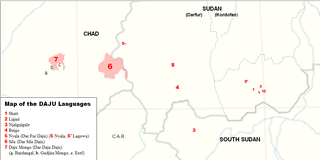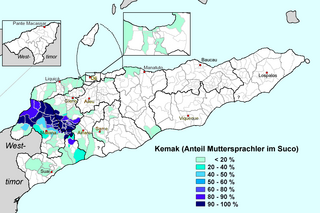Related Research Articles

Darfur is a region of western Sudan. Dār is an Arabic word meaning "home [of]" – the region was named Dardaju while ruled by the Daju, who migrated from Meroë c. 350 AD, and it was renamed Dartunjur when the Tunjur ruled the area. Darfur was an independent sultanate for several hundred years until 1874, when it fell to the Sudanese warlord Rabih az-Zubayr. The region was later invaded and incorporated into Sudan by Anglo-Egyptian forces in 1916. As an administrative region, Darfur is divided into five federal states: Central Darfur, East Darfur, North Darfur, South Darfur and West Darfur. Because of the War in Darfur between Sudanese government forces and the indigenous population, the region has been in a state of humanitarian emergency and genocide since 2003. The factors include religious and ethnic rivalry, and the rivalry between farmers and herders.
The Kujargé language is spoken in seven villages in eastern Chad near Jebel Mirra, and in villages scattered along the lower Wadi Salih and Wadi Azum in Darfur, Sudan. It is estimated to have about 1,000 speakers.
The Saho language is an Afro-Asiatic language spoken in Eritrea, Sudan and Ethiopia. It belongs to the family's Cushitic branch.

The Daju languages are spoken in isolated pockets by the Daju people across a wide area of Sudan and Chad. In Sudan, they are spoken in parts of the regions of Kordofan and Darfur, in Chad they are spoken in Wadai. The Daju languages belong to the Eastern Sudanic subfamily of Nilo-Saharan.
The Shatt language is a Daju language of the Eastern Daju family spoken by the Shatt people in the Shatt Hills southwest of Kaduqli in South Kordofan province in southern Sudan.
Naba is a Nilo-Saharan language spoken by approximately 500,000 people in Chad. Those who speak this language are called Lisi, a collective name for three closely associated ethnic groups, the Bilala, the Kuka and the Medogo, that represent the three dialects in which Naba is subdivided. They live mainly in the Batha Prefecture, but the Kuka are also in Chari-Baguirmi. Ethnologue estimates the lexical similarity among the three dialects to be no less than 99%. Arabic is often spoken as a second language.

Kemak is a language spoken in East Timor and in the border region of Indonesian West Timor. An alternate name is Ema. It is most closely related to Tocodede and Mambai. It has the status of one of the national languages in the East Timor constitution, besides the official languages of Portuguese and Tetum. The number of speakers has fallen in recent years.
Dar Sila is the name of the wandering sultanate of the Dar Sila Daju, a multi-tribal ethnic group in Chad and Sudan. The number of the people in this group exceeds 50,000. They speak the Sila language, a Nilo-Saharan language. Most members of this ethnic group are Muslims.
The Daju people are a group of seven distinct ethnicities speaking related languages living on both sides of the Chad-Sudan border and in the Nuba Mountains. Separated by distance and speaking different languages, at present, they generally have little cultural affinity to each other.
Yeyi is a Bantu language spoken by many of the approximately 50,000 Yeyi people along the Okavango River in Namibia and Botswana. Yeyi, influenced by Juu languages, is one of several Bantu languages along the Okavango with clicks. Indeed, it has the largest known inventory of clicks of any Bantu language, with dental, alveolar, palatal, and lateral articulations. Though most of its older speakers prefer Yeyi in normal conversation, it is being gradually phased out in Botswana by a popular move towards Tswana, with Yeyi only being learned by children in a few villages. Yeyi speakers in the Caprivi Strip of north-eastern Namibia, however, retain Yeyi in villages, but may also speak the regional lingua franca, Lozi.
Nyala, also known as Dar Fur, Darfur Daju, Daju Darfur, Beke, Dagu, Daju Ferne and Fininga, is an Eastern Sudanic language of Sudan, one of three closely related languages in the area called "Daju". It is spoken near Nyala, the capital of South Darfur province by the Dar Fur Daju people. There are two divergent dialects: Nyala and Lagowa.
The Sila language, also known as Dar Sila, Dar Sila Daju, Bokor, Bokorike, Bokoruge, Dadjo, Dajou, Daju, and Sula, is an Eastern Sudanic language, one of three closely related languages in the area called "Daju". It is spoken in Chad near the Darfur border, with migration into Sudan. There are two dialects, Sila proper and Mongo, the latter not to be confused with Daju Mongo.
Chokri, is one of three languages spoken by the Chakhesang Naga of Phek district, Nagaland state, India. There are also some Chokri speakers residing in the Senapati District of Manipur. In 1991, it was estimated that there were 20,000 native Chokri speakers.
Kemberano is a Papuan language of the Bird's Head Peninsula of West Papua, Indonesia.
Barawana (Baré) is an Arawakan language of Venezuela and Brazil, where it is nearly extinct. It was spoken by the Baré people. Aikhenvald (1999) reports "just a few old speakers left" of Baré proper, and that the Guinau variety was extinct. Kaufman (1994) considers Baré proper, Guinau, and Marawá to be distinct languages; Aikhenvald, dialects of a single languages.
Yamdena is an Austronesian language of Yamdena and surrounding islands in the Maluku Islands in Indonesia. In 1991 there were an estimated 25,000 speakers of the language. Current BPS data has the present number of speakers at 69,000.
Ngadjunmaya, correctly known as Ngadjumaya, is a Pama–Nyungan language of Western Australia that is located in the Goldfields-Esperance region.
The Dar Daju Daju are an ethnic group numbering 34,000 people in the Guéra Region of southwestern Chad. They are one of seven distinct ethnicities comprising the Daju people. They speak the Daju Mongo language and are mostly Muslim.
The Dar Fur Daju are an ethnic group in the Sudan. They are one of seven distinct ethnicities comprising the Daju people. They speak the Nyala language. They live in Southern Darfur in the Sudan in the Daju Hills 40 km northeast of Nyala - although most of this population has fled to Chad as a result of the Darfur Conflict. There is also a small population of Dar Fur Daju near the city of Lagowa in the Nuba Hills. Their total population numbers 98,000 (2017). They are mostly Muslim.
The Kujarke people are a little-known ethnic group of the Ouaddaï Region in eastern Chad and South Darfur, Sudan. They speak Kujargé, a divergent, unclassified Afro-Asiatic language. Their current population and locations are unknown due to the war in Darfur. Furthermore, they have not been previously recorded as a separate ethnic group by any government or foreign aid organization.
References
- ↑ Daju Dar Daju at Ethnologue (25th ed., 2022)

- ↑ Aviles, Arthur J. (2008). The phonology and morphology of the Dar Daju Daju language. University of North Dakota.